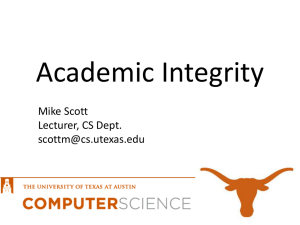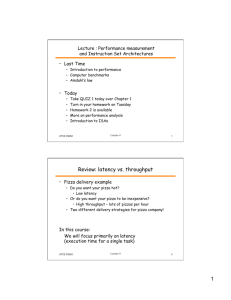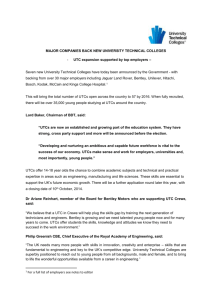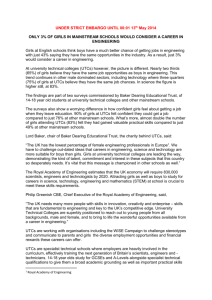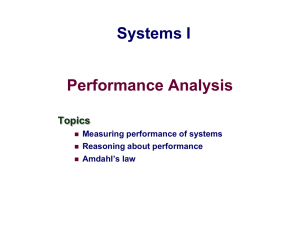1 Lecture 3: Evaluating Computer Architectures Software
advertisement
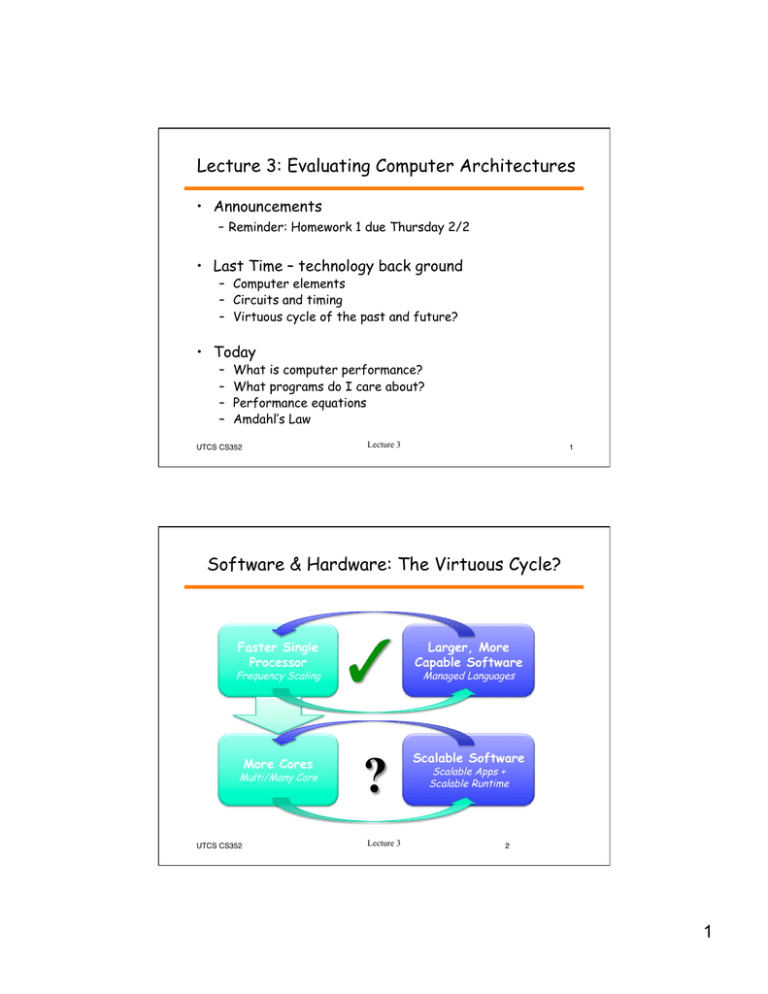
Lecture 3: Evaluating Computer Architectures • Announcements - Reminder: Homework 1 due Thursday 2/2 • Last Time – technology back ground – Computer elements – Circuits and timing – Virtuous cycle of the past and future? • Today – – – – What is computer performance? What programs do I care about? Performance equations Amdahl’s Law Lecture 3 UTCS CS352 1 Software & Hardware: The Virtuous Cycle? Faster Single Processor Frequency Scaling More Cores Multi/Many Core UTCS CS352 ✓ ? Lecture 3 Larger, More Capable Software Managed Languages Scalable Software Scalable Apps + Scalable Runtime 2 1 Performance Hype “AMD Performance Preview: Taking Phenom II to 4.2 GHz” “Intel Core i7…8 processing threads… They are the best desktop processor family on the planet.” “With 8 cores, each supporting 4 threads, the UltraSPARC T1 processor executes 32 simultaneous threads within a design consuming only 72 watts of power.“ “…improves throughput by up to 41x” “speed up by 10-25% in many cases…” “…about 2x in two cases…” “…more than 10x in two small benchmarks” “speedups of 1.2x to 6.4x on a variety of benchmarks” “can reduce garbage collection time by 50% to 75%” “…demonstrating high efficiency and scalability” “our prototype has usable performance” “speedups…. are very significant (up to 54-fold)” “sometimes more than twice as fast” “our …. is better or almost as good as …. across the board” UTCS CS352 Lecture 3 3 4 What Does this Graph Mean? Performance Trends on SPEC Int 2000 UTCS CS352 Lecture 3 2 Computer Performance Evaluation • Metric = something we measure • Goal: Evaluate how good/bad a design is • Examples – – – – – Clock rate of computer Power consumed by a program Execution time for a program Number of programs executed per second Cycles per program instruction • How should we compare two computer systems? Lecture 3 UTCS CS352 5 Tradeoff: latency vs. throughput • Pizza delivery – Do you want your pizza hot? – Or do you want your pizza to be inexpensive? – Two different delivery strategies for pizza company! This course focuses primarily on latency (hot pizza) Latency = execution time for a single task Throughput = number of tasks per unit time UTCS CS352 Lecture 3 6 3 Two notions of “performance” Plane DC to Paris Speed Passengers Throughput (pmph) Boeing 747 6.5 hours 610 mph 470 286,700 Concorde 3 hours 1350 mph 132 178,200 Which has plane higher performance? ° Time to do the task (Execution Time) – execution time, response time, latency ° Tasks per day, hour, week, sec, ns. .. (Performance) – throughput, bandwidth UTCS CS352 Slide courtesy of D. Patterson Lecture 3 7 8 Definitions • Performance is in units of things-per-second – bigger is better • Response time of a system Y running program Z performance (Y) = 1 execution time (Z on Y) • Throughput of system Y running many programs performance (Y) = number of programs unit time • " System X is n times faster than Y" means n = performance(X) performance(Y) UTCS CS352 Slide courtesy of D. Patterson Lecture 3 4 Definitions • Performance is in units of things-per-second – bigger is better • Response time of a system Y running program Z performance (Y) = 1 execution time (Z on Y) • Throughput of system Y running many programs performance (Y) = number of programs unit time • " System X is n times faster than Y" means n = performance(X) performance(Y) UTCS CS352 Slide courtesy of D. Patterson Lecture 3 9 10 Which Programs Should I Measure? UTCS CS352 Slide courtesy of D. Patterson Lecture 3 5 Which Programs Should I Measure? Pros Cons Actual Target Workload Full Application Benchmarks Small “Kernel” Benchmarks Microbenchmarks UTCS CS352 Slide courtesy of D. Patterson Lecture 3 11 Which Programs Should I Measure? Pros Cons • representative Actual Target Workload • portable • widely used • improvements useful in reality Full Application Benchmarks • easy to run, early in design cycle • identify peak capability and potential bottlenecks UTCS CS352 Slide courtesy of D. Patterson Small “Kernel” Benchmarks Microbenchmarks Lecture 3 • very specific • non-portable • difficult to run, or measure • hard to identify cause • less representative • easy to “fool” • “peak” may be a long way from application performance 12 6 Brief History of Benchmarking • Early days (1960s) – Single instruction execution time – Average instruction time [Gibson 1970] – Pure MIPS (1/AIT) • Simple programs(early 70s) – Synthetic benchmarks (Whetstone, etc.) – Kernels (Livermore Loops) • Relative Performance (late 70s) – VAX 11/780 ≡ 1-MIPS • but was it? – MFLOPs UTCS CS352 • “Real” Applications (1989-now) – SPEC CPU C/Fortran • Scientific, Irregular • 89, 92, 95, 00, 07, ?? – TPC C: Transaction Processing – SPECWeb – WinBench: Desktop – Graphics C/C++ • Quake III, Doom 3 • MediaBench – Java: SPECJVM98 • Problem: Programming Language – – – Lecture 3 Parallel?, Java, C#, JavaScript?? DaCapo Java Benchmarks 06, 09 Parsec: Parallel C/C++, 2008 13 How to Compromise a Comparison: C programs running on two architectures UTCS CS352 Lecture 3 14 7 The compiler reorganized the code! • Change the memory system performance – Matrix multiply cache blocking After Before UTCS CS352 Lecture 3 15 There are lies, damn lies, and statistics Desraeli UTCS CS352 Lecture 3 16 8 benchmarks There are lies, damn lies, and statistics ✗ UTCS CS352 Lecture 3 Desraeli 17 Benchmarking Java Programs • Let’s consider the performance of the DaCapo Java Benchmarks • What do we need to think about when comparing two computers running Java programs? • http://dacapo.anu.edu.au/regression/perf /2006-10-MR2.html UTCS CS352 Lecture 3 18 9 Pay Attention to Benchmarks & System • Benchmarks measure the whole system • Benchmark timings are sensitive – application – compiler, VM, memory management – operating system – architecture – implementation – alignment in cache – location of data on disk – values of data • Danger of inbreeding or positive feedback • Popular benchmarks often reflect yesterday’s programs – what about the programs people are running today? – need to design for tomorrow’s problems – if you make an operation fast (slow) it will be used more (less) often • therefore you make it faster (slower) – and so on, and so on… – the optimized NOP Lecture 3 UTCS CS352 19 20 Performance Summary so Far • Key concepts – Throughput and Latency • Best benchmarks are real programs – DaCapo, Spec, TPC, Doom3 • Pitfalls – Whole system measurement – Workload may not match user’s – Compiler, VM, memory management • Next – Amdahl’s Law UTCS CS352 Lecture 3 10 Improving Performance: Fundamentals • Suppose we have a machine with two instructions – Instruction A executes in 100 cycles – Instruction B executes in 2 cycles • We want better performance…. – Which instruction do we improve? UTCS CS352 Lecture 3 21 22 Speedup • Make a change to an architecture • Measure how much faster/slower it is UTCS CS352 Lecture 3 11 Speedup when we know details about the change • Performance improvements depend on: – how good is enhancement (factor S) – how often is it used (fraction p) • Speedup due to enhancement E: Speedup(E) = ExTime w/out E Perf w/ E = ExTime w/ E Perf w/out E € UTCS CS352 Lecture 3 23 24 Amdahl’s Law: Example • FP instructions improved by 2x • But….only 10% of instructions are FP 0.1 ExTimenew = ExTimeold ∗ 0.9 + = 0.95 ∗ ExTimeold 2 • € Amdahl’s Law: Speedup bounded by UTCS CS352 Lecture 3 12 How Does Amdahl’s Law Apply to Multicore? • Given N cores what is our ideal speedup? UTCS CS352 Lecture 3 25 How Does Amdahl’s Law Apply to Multicore? • Given N cores what is our ideal speedup? ExTimenew = ExTimeold /N • Say 90% of the code is parallel and N = 16? € UTCS CS352 Lecture 3 26 13 How Does Amdahl’s Law Apply to Multicore? • Given N cores what is our ideal speedup? ExTimenew = ExTimeold /N • Say 90% of the code is parallel and N = 16? € p ExTimenew = ExTimeold ∗ (1− p) + N 0.9 ExTimenew = ExTimeold ∗ 0.1+ = 0.15625 ∗ ExTimeold 16 € Speeduptotal = € 1 = 6.2 0.15625 Lecture 3 UTCS CS352 27 € How Does Amdahl’s Law Apply to Multicore? UTCS CS352 Lecture 3 28 14 Performance Summary so Far • Amdahl’s law: Pay attention to what are you speeding up. • Next Time – More on Performance • Cycles per Instruction • Means – Start: Instruction Set Architectures (ISA) – Read: P&H 2.1 – 2.5 – Turn in your homework at the beginning of class UTCS CS352 Lecture 3 29 15
